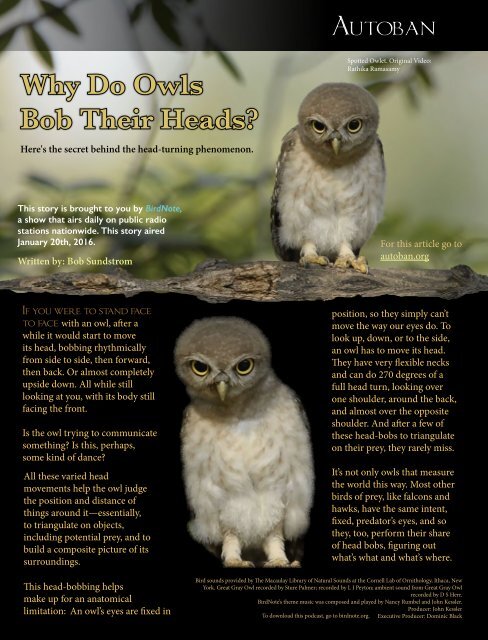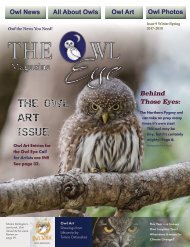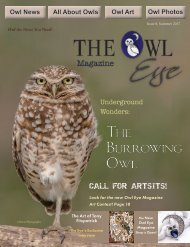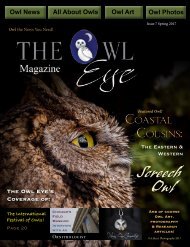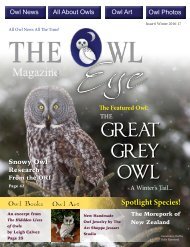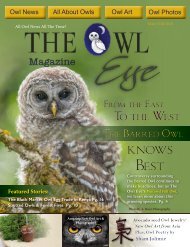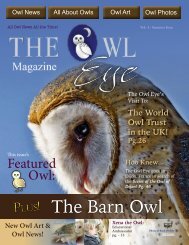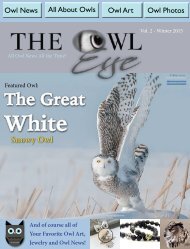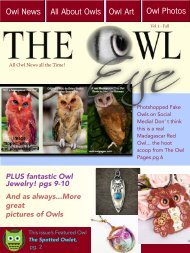The Owl Eye Spring 2016
Here is the new Owl Eye Issue 3 for Spring. This issue features the Owl Eye's account of the International Festival of Owls, March, 2016.
Here is the new Owl Eye Issue 3 for Spring. This issue features the Owl Eye's account of the International Festival of Owls, March, 2016.
Create successful ePaper yourself
Turn your PDF publications into a flip-book with our unique Google optimized e-Paper software.
Autoban<br />
Why Do <strong>Owl</strong>s<br />
Bob <strong>The</strong>ir Heads?<br />
Spotted <strong>Owl</strong>et. Original Video:<br />
Rathika Ramasamy<br />
Wildlife Rehabilitation and Education<br />
Habitat and Species Conservation<br />
1521 S. Linn White Drive Chicago, Illinois 60605<br />
Here's the secret behind the head-turning phenomenon.<br />
This story is brought to you by BirdNote,<br />
a show that airs daily on public radio<br />
stations nationwide. This story aired<br />
January 20th, <strong>2016</strong>.<br />
Written by: Bob Sundstrom<br />
For this article go to<br />
autoban.org<br />
Trill, <strong>The</strong> Eastern<br />
Screech <strong>Owl</strong><br />
Article By Lisa Spiegelman<br />
If you were to stand face<br />
to face with an owl, after a<br />
while it would start to move<br />
its head, bobbing rhythmically<br />
from side to side, then forward,<br />
then back. Or almost completely<br />
upside down. All while still<br />
looking at you, with its body still<br />
facing the front.<br />
Is the owl trying to communicate<br />
something? Is this, perhaps,<br />
some kind of dance?<br />
All these varied head<br />
movements help the owl judge<br />
the position and distance of<br />
things around it—essentially,<br />
to triangulate on objects,<br />
including potential prey, and to<br />
build a composite picture of its<br />
surroundings.<br />
This head-bobbing helps<br />
make up for an anatomical<br />
limitation: An owl’s eyes are fixed in<br />
position, so they simply can’t<br />
move the way our eyes do. To<br />
look up, down, or to the side,<br />
an owl has to move its head.<br />
<strong>The</strong>y have very flexible necks<br />
and can do 270 degrees of a<br />
full head turn, looking over<br />
one shoulder, around the back,<br />
and almost over the opposite<br />
shoulder. And after a few of<br />
these head-bobs to triangulate<br />
on their prey, they rarely miss.<br />
It’s not only owls that measure<br />
the world this way. Most other<br />
birds of prey, like falcons and<br />
hawks, have the same intent,<br />
fixed, predator’s eyes, and so<br />
they, too, perform their share<br />
of head bobs, figuring out<br />
what’s what and what’s where.<br />
Bird sounds provided by <strong>The</strong> Macaulay Library of Natural Sounds at the Cornell Lab of Ornithology, Ithaca, New<br />
York. Great Gray <strong>Owl</strong> recorded by Sture Palmer; recorded by L J Peyton; ambient sound from Great Gray <strong>Owl</strong><br />
recorded by D S Herr.<br />
BirdNote’s theme music was composed and played by Nancy Rumbel and John Kessler.<br />
Producer: John Kessler<br />
To download this podcast, go to birdnote.org. Executive Producer: Dominic Black<br />
I had the great pleasure of<br />
meeting two owls, Trill, pictured<br />
above, an Eastern Screech <strong>Owl</strong> and<br />
Justice, below, a Great Horned <strong>Owl</strong><br />
on February 20th at the Flint Creek<br />
Wildlife Rehabilitation Center in<br />
Chicago, Polar Adventure Days. <strong>The</strong>y<br />
are two embassador birds from Flint<br />
and do education programs in schools<br />
and other events.<br />
Flint Creek does amazing work for<br />
owls and other birds of prey by<br />
rescuing injured animals, caring for<br />
them, and releasing them into the<br />
wild if possible. <strong>The</strong>y have extensive<br />
educational programs, including a<br />
Raptor Internship - where you can<br />
be involved with learning about and<br />
caring for owls.<br />
You can read more about Flint Creek and<br />
their events at:<br />
www.flintcreekwildlife.org and of course<br />
follow them on Facebook<br />
Justice, the Great Horned <strong>Owl</strong><br />
35


